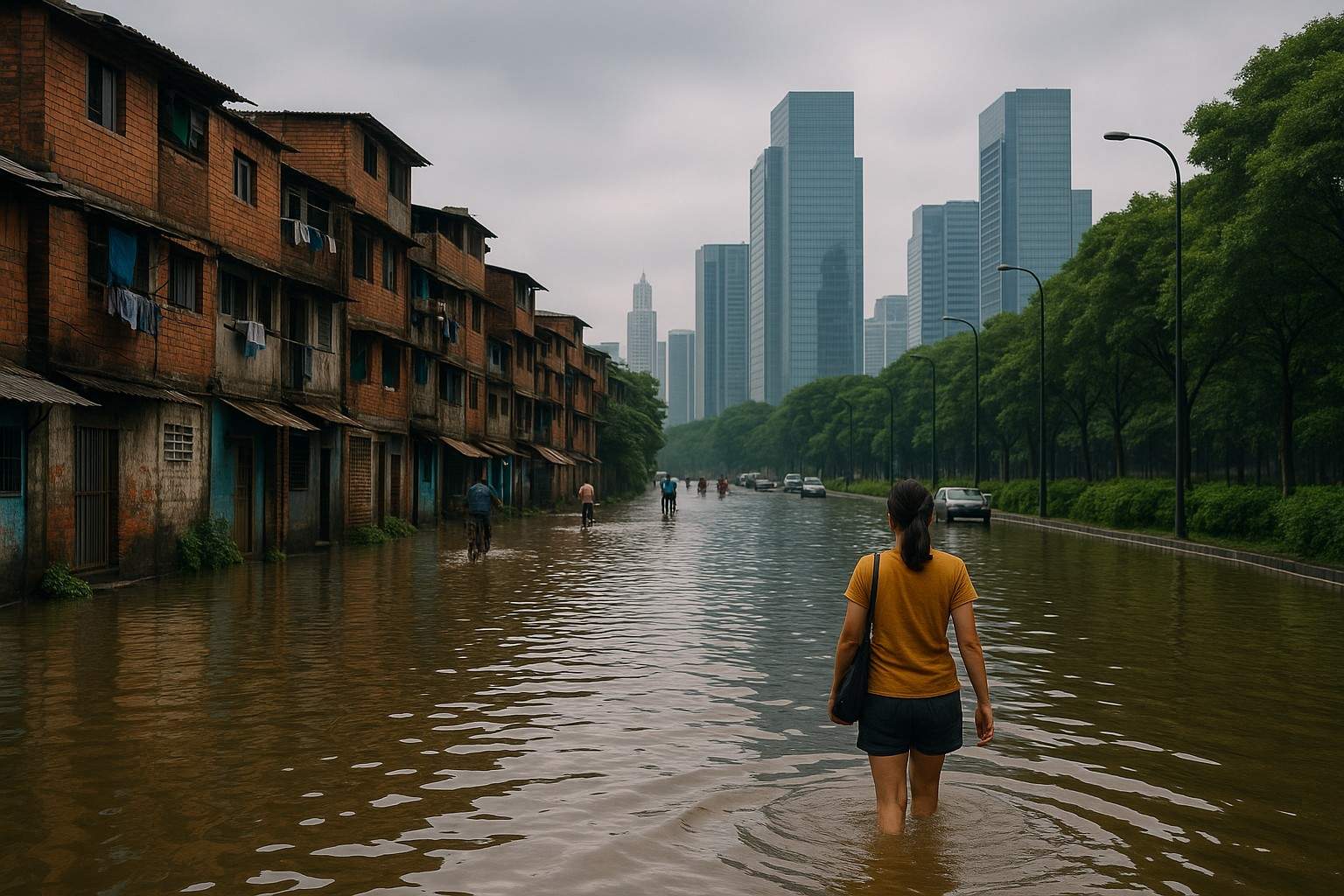Climate change is one of the most pressing global challenges of the 21st century, with inconsistent impacts on vulnerable and marginalized communities. Environmental justice, a concept that advocates for the fair treatment and meaningful involvement of all people in environmental laws and policies, has become central to addressing climate-related disparities. This paper explores the intersection of environmental justice and climate change in the present-day global and Indian context. It analyzes how socio-economically disadvantaged populations suffer the brunt of environmental poverty and climate-related disasters. The article further discusses key international frameworks, national laws, and landmark judicial decisions that have shaped the discourse on environmental justice. Recommendation is offered for a more inclusive, equitable approach to climate action, emphasizing the integration of human rights and sustainable development goals. . Developed nations have historically contributed the most to greenhouse gas emissions, while developing countries and impoverished communities face the worst consequences. However, its impacts are not felt equally across societies. Environmental justice defined as the fair treatment and meaningful involvement of all people regardless of race, color, national origin, or income has become a critical lens through which the climate crisis must be addressed
Keywords: Environmental Justice, Climate Change, Human Rights, Vulnerable Communities, Sustainable Development, Climate Policy, India, Case
1. Introduction
Environmental justice and climate change are interlinked concerns that cannot be addressed in isolation. The core principle of environmental justice is to ensure that no group of people, especially marginalized or economically disadvantaged ones bears a disproportionate share of negative environmental consequences. In today’s scenario, the inequitable effects of climate change rising sea levels, frequent extreme weather events, food and water insecurity are starkly evident across the globe. Developed nations have historically contributed the most to greenhouse gas emissions, while developing countries and impoverished communities face the worst consequences. The need for integrating environmental justice into climate policy and governance is not just a moral imperative but also a legal and constitutional duty, especially in countries like India. In the contemporary world, climate change has emerged as one of the most pressing global challenges, affecting ecosystems, economies, and communities. However, its impacts are not felt equally across societies. Environmental justice defined as the fair treatment and meaningful involvement of all people regardless of race, color, national origin, or income has become a critical lens through which the climate crisis must be addressed. Marginalized communities, particularly in developing nations and low-income urban areas, often face the brunt of climate-related hazards such as extreme weather events, rising sea levels, and pollution, while contributing the least to greenhouse gas emissions. In today’s scenario, the intersection of environmental justice and climate change demands urgent attention, highlighting the need for inclusive policies, equitable resource distribution, and recognition of vulnerable populations in climate action strategies. Only through a just and equitable approach can global climate goals be achieved in a way that benefits all segments of society.
2. Understanding Environmental Justice
Environmental justice emerges as a civil rights issue in the United States during the 1980s, importance the unequal environmental burden borne by low-income and minority communities. Over time, the concept evolved into a global human rights issue that calls for equitable distribution of environmental benefits and burdens, inclusive participation in decision-making, and the right to a clean and healthy environment.
Key principles of environmental justice include:
- Equal protection under environmental laws
- Informed public participation in policy-making
- Transparency and accountability in environmental governance
- Remedies for environmental harms
3. Climate Change and Inequality
1. Global Impact of Climate Change
Climate change manifest through rising global temperatures, altered rain patterns, sea-level rise, and an increase in the frequency and severity of natural disasters. While these phenomenons affect all nations, their consequences are disproportionately severe for poor and developing regions.
2. Climate Vulnerability of Marginalized Communities
Marginalized groups often live in high-risk areas such as floodplains or degraded urban environments and lack the financial resilience to recover from environmental shocks. They may also depend heavily on climate-sensitive resources such as agriculture and fisheries. These vulnerabilities are further compounded by poor infrastructure, inadequate access to healthcare, and limited political representation.
4. Environmental Justice in the Indian background
India is one of the country’s most vulnerable to climate change, facing severe droughts, floods, and heat waves. The country also has deep socio-economic inequalities, making environmental justice particularly relevant. Environmental justice in India, a concept focused on ensuring fair treatment and meaningful involvement of all people in environmental decision-making, addresses the unequal distribution of environmental burdens and benefits. This includes issues like pollution, resource exploitation, and environmental degradation, which disproportionately affect marginalized communities. India’s approach to environmental justice has evolved, with the National Green Tribunal (NGT) playing a crucial role in handling environmental disputes and recognizing the right to a healthy environment as a fundamental right. Environmental justice in the Indian context focuses on ensuring fair treatment and meaningful involvement of all people, regardless of their socio-economic status, with respect to environmental laws, regulations, and policies. It addresses the disproportionate burden of environmental degradation on marginalized communities, advocating for their rights to access resources and a healthy environment. Indian environmental justice movements have a long history, stemming from grassroots resistances against colonial exploitation and accelerated industrialization.
1 Legislative structure
India has several environmental laws and constitutional provisions that support the principle of environmental justice:
- Article 21: Guarantees the right to life, interpreted by courts to include the right to a healthy environment.
- Environment (Protection) Act, 1986: Empowers the central government to take measures to protect and improve the environment.
- Forest Rights Act, 2006: recognize the rights of forest-dwelling community.
2 Government Initiatives
- National Action Plan on Climate Change (NAPCC): Includes missions on solar energy, sustainable agriculture, water, and more.
- State Action Plans on Climate Change (SAPCCs): Customized strategies developed by individual Indian states.
Despite these efforts, implementation challenges and a lack of community involvement often hinder effective climate action.
5. Case Law Analysis
1. M.C. Mehta v. Union of India (1987)
This landmark case on environmental pollution led the Supreme Court to declare the right to live in a pollution-free environment as a part of Article 21. The court emphasizes the importance of sustainable development and strict liability for environmental damage.
2. Indian Council for Environ-Legal Action v. Union of India (1996)
This case enforced the “polluter pays” principle. It held industrial units accountable for causing environmental damage and ordered them to compensate affected villagers, setting a precedent for environmental accountability.
3. Vellore Citizens’ Welfare Forum v. Union of India (1996)
The court recognized the concept of “sustainable development” and integrated it into Indian jurisprudence. It emphasized the need to balance economic development with environmental protection.
4. T.N. Godavarman Thirumulpad v. Union of India
This ongoing series of cases deals with forest conservation in India and has led to judicial oversight of forest policy and forestation efforts. It underscores judicial activism in ensuring environmental protection.
6. International Frameworks and Environmental Justice
Several international agreements and institutions promote the integration of environmental justice into climate policy:
- Paris Agreement (2015): Stresses the importance of equity and “common but differentiated responsibilities.”
- Kyoto Protocol: Acknowledged the responsibility of developed nations in reducing emissions.
- UN Sustainable Development Goals (SDGs): Particularly SDG 13 (Climate Action) and SDG 10 (Reduced Inequalities) align with environmental justice.
- Aarhus Convention: Ensures access to environmental information and justice.
These frameworks emphasize the necessity of participatory governance and equitable climate action across borders.
7. Challenges to Achieving Environmental Justice:- Achieving environmental justice faces several significant challenges. One major issue is the unequal distribution of environmental harms, such as pollution and hazardous waste, which disproportionately affect low-income and marginalized communities. These communities often lack political power or resources to oppose environmentally harmful developments. Additionally, systemic racism and historical discrimination have led to residential segregation, placing vulnerable populations closer to industrial zones and other sources of pollution. Another challenge is inadequate enforcement of environmental regulations in these areas, allowing violations to persist unchecked. Furthermore, limited access to information and public participation in decision-making processes prevents affected communities from advocating effectively for their rights. Climate change intensifies these disparities, as disadvantaged groups are more exposed to its impacts yet have fewer means to recover. Overcoming these challenges requires inclusive policymaking, stronger legal protections, and targeted support to ensure that all communities can live in a healthy and sustainable environment.
Lack of Data:-Poor documentation and data on local climate impacts hinder targeted interventions.
- Inequitable Policy Design: Policies often favor urban or industrial interests over rural or indigenous communities.
- Implementation Gaps: Weak enforcement of environmental regulations undermines legal protections.
- Climate Finance: Access to international climate finance remains limited for grassroots or community-led initiatives.
- Technological Barriers: Clean energy and adaptation technologies are often inaccessible to vulnerable communities.
8. Recommendations and Way Forward
- Inclusive Climate Governance
Involve marginalized groups, especially indigenous communities, in policy-making through participatory platforms. - Equitable Resource Allocation
Ensure fair distribution of climate finance, disaster relief, and technological support to vulnerable populations. - Strengthen Legal Frameworks
Enhance environmental laws to explicitly include justice principles and enable stronger enforcement mechanisms. - Capacity Building and Education
Promote environmental literacy and resilience strategies at the community level through education and training programs. - Monitoring and Accountability
Establish robust systems to monitor environmental degradation and hold polluters accountable through administrative and judicial actions.
9. Conclusion
Environmental justice must be the cornerstone of contemporary climate policy. As the climate crisis accelerate, ensuring that susceptible populations are protected, included, and empower becomes not only a matter of ethics but of survival. Legal systems, civil society, and government must collaborate to create equitable solutions rooted in sustainability and justice. India’s judiciary has played a critical role in developing environmental jurisprudence, but a proactive, multi-sect oral approach is essential to bring about real change. In today’s world, the junction of environmental justice and climate change reveals a pressing moral and social imperative. Climate change does not affect all communities equally marginalized and low-income populations often bear the brunt of its impacts despite causal the least to its causes. Environmental justice demands that these disparities be addressed through equitable policies, inclusive decision-making, and global cooperation. As climate threats intensify, achieving justice is not just about protecting the environment it’s about protecting human rights, promoting resilience, and ensuring that no community is left behind in the pursuit of a sustainable and just future.
References
- M.C. Mehta v. Union of India, AIR 1987 SC 965.
- Indian Council for Enviro-Legal Action v. Union of India, (1996) 3 SCC 212.
- Vellore Citizens Welfare Forum v. Union of India, (1996) 5 SCC 647.
- T.N. Godavarman Thirumulpad v. Union of India, (1997) 2 SCC 267.
- Environment (Protection) Act, 1986.
- Constitution of India, Article 21.
- National Action Plan on Climate Change (NAPCC), Government of India.
- Paris Agreement, 2015.
- UN Sustainable Development Goals, 2015.
- Bullard, R. D. (2000). “Dumping in Dixie: Race, Class, and Environmental Quality.”
- Agarwal, A. and Narain, S. (1991). “Global Warming in an Unequal World: A Case of Environmental Colonialism.” Centre for Science and Environment, India.
- United Nations Framework Convention on Climate Change (UNFCCC).
– Dr. Meenu D. Sharma, Assistant Professor
Faculty of Law, Madhav University (Abu road)

